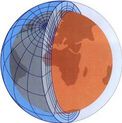Models
About a century ago, some scientists sought to make a numerical model of the atmosphere in order to see its evolution. It is only during the 70’s that numerical weather prediction models really came into being in most advanced meteorological services. They have become an essential tool in weather prediction, but forecasters’ expertise is still priceless. Ever since, weather prediction (with simulations of tomorrow climate changes as its cognate component), always a big computing resource hungry, is a showcase for super computer manufacturers.
Practical meteorological applications often require a strong synergy between atmospheric modellisation and observations, hence the strong bearing of modellisation also called “data assimilation”. Atmospheric modellisation alone falls short for such application as weather prediction, what is required is an overall modellisation of the entire globe, including deep ocean water, the cryosphere as well as the land surface and the upper part of the mantle.
At Météo France, research undertaken by the teams of CNRM aims to improve operational numerical weather prediction models (dynamics, physics, …). Major developments are carried out in data assimilation so as to fuel weather prediction models with all encompassing data (ship observations, buoys, satellites …)
Alongside, experimental models are being developed and tested using the latest innovations and will, in the near future, replace existing operational models.




